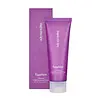What's inside
What's inside
 Key Ingredients
Key Ingredients

 Benefits
Benefits

 Concerns
Concerns

 Ingredients Side-by-side
Ingredients Side-by-side

Water
Skin ConditioningGlycerin
HumectantSodium Cocoyl Glycinate
CleansingSodium Lauroyl Glutamate
1,2-Hexanediol
Skin ConditioningButylene Glycol
HumectantHydroxypropyl Starch Phosphate
Solanum Melongena Fruit Extract
Skin ConditioningLauryl Betaine
CleansingHydroxyacetophenone
AntioxidantEthylhexylglycerin
Skin ConditioningSodium Chloride
MaskingDecylene Glycol
Skin ConditioningTocopherol
AntioxidantGluconolactone
Skin ConditioningBetaine Salicylate
AntimicrobialCitric Acid
BufferingWater, Glycerin, Sodium Cocoyl Glycinate, Sodium Lauroyl Glutamate, 1,2-Hexanediol, Butylene Glycol, Hydroxypropyl Starch Phosphate, Solanum Melongena Fruit Extract, Lauryl Betaine, Hydroxyacetophenone, Ethylhexylglycerin, Sodium Chloride, Decylene Glycol, Tocopherol, Gluconolactone, Betaine Salicylate, Citric Acid
Water
Skin ConditioningSodium Cocoyl Alaninate
Glycerin
HumectantDipropylene Glycol
HumectantCoco-Glucoside
CleansingAcrylates/C10-30 Alkyl Acrylate Crosspolymer
Emulsion StabilisingLauryl Glucoside
CleansingPotassium Cocoate
EmulsifyingPentylene Glycol
Skin Conditioning1,2-Hexanediol
Skin ConditioningCentella Asiatica Extract
CleansingCeramide NP
Skin ConditioningActinidia Chinensis Fruit Extract
EmollientBeta-Glucan
Skin ConditioningSalicylic Acid
MaskingHydroxyacetophenone
AntioxidantEthylhexylglycerin
Skin ConditioningDecylene Glycol
Skin ConditioningSodium Phytate
Butylene Glycol
HumectantHydrogenated Lecithin
EmulsifyingFicus Carica Fruit Extract
HumectantEDTA
Tocopherol
AntioxidantWater, Sodium Cocoyl Alaninate, Glycerin, Dipropylene Glycol, Coco-Glucoside, Acrylates/C10-30 Alkyl Acrylate Crosspolymer, Lauryl Glucoside, Potassium Cocoate, Pentylene Glycol, 1,2-Hexanediol, Centella Asiatica Extract, Ceramide NP, Actinidia Chinensis Fruit Extract, Beta-Glucan, Salicylic Acid, Hydroxyacetophenone, Ethylhexylglycerin, Decylene Glycol, Sodium Phytate, Butylene Glycol, Hydrogenated Lecithin, Ficus Carica Fruit Extract, EDTA, Tocopherol
Ingredients Explained
These ingredients are found in both products.
Ingredients higher up in an ingredient list are typically present in a larger amount.
1,2-Hexanediol is a synthetic liquid and another multi-functional powerhouse.
It is a:
- Humectant, drawing moisture into the skin
- Emollient, helping to soften skin
- Solvent, dispersing and stabilizing formulas
- Preservative booster, enhancing the antimicrobial activity of other preservatives
Butylene Glycol (or BG) is used within cosmetic products for a few different reasons:
Overall, Butylene Glycol is a safe and well-rounded ingredient that works well with other ingredients.
Though this ingredient works well with most skin types, some people with sensitive skin may experience a reaction such as allergic rashes, closed comedones, or itchiness.
Learn more about Butylene GlycolWe don't have a description for Decylene Glycol yet.
Ethylhexylglycerin (we can't pronounce this either) is commonly used as a preservative and skin softener. It is derived from glyceryl.
You might see Ethylhexylglycerin often paired with other preservatives such as phenoxyethanol. Ethylhexylglycerin has been found to increase the effectiveness of these other preservatives.
Glycerin is already naturally found in your skin. It helps moisturize and protect your skin.
A study from 2016 found glycerin to be more effective as a humectant than AHAs and hyaluronic acid.
As a humectant, it helps the skin stay hydrated by pulling moisture to your skin. The low molecular weight of glycerin allows it to pull moisture into the deeper layers of your skin.
Hydrated skin improves your skin barrier; Your skin barrier helps protect against irritants and bacteria.
Glycerin has also been found to have antimicrobial and antiviral properties. Due to these properties, glycerin is often used in wound and burn treatments.
In cosmetics, glycerin is usually derived from plants such as soybean or palm. However, it can also be sourced from animals, such as tallow or animal fat.
This ingredient is organic, colorless, odorless, and non-toxic.
Glycerin is the name for this ingredient in American English. British English uses Glycerol/Glycerine.
Learn more about GlycerinHydroxyacetophenone is antioxidant with skin conditioning and soothing properties. It also boosts the efficiency of preservatives.
This ingredient is not irritating or sensitizing.
Tocopherol (also known as Vitamin E) is a common antioxidant used to help protect the skin from free-radicals and strengthen the skin barrier. It's also fat soluble - this means our skin is great at absorbing it.
Vitamin E also helps keep your natural skin lipids healthy. Your lipid skin barrier naturally consists of lipids, ceramides, and fatty acids. Vitamin E offers extra protection for your skin’s lipid barrier, keeping your skin healthy and nourished.
Another benefit is a bit of UV protection. Vitamin E helps reduce the damage caused by UVB rays. (It should not replace your sunscreen). Combining it with Vitamin C can decrease sunburned cells and hyperpigmentation after UV exposure.
You might have noticed Vitamin E + C often paired together. This is because it is great at stabilizing Vitamin C. Using the two together helps increase the effectiveness of both ingredients.
There are often claims that Vitamin E can reduce/prevent scarring, but these claims haven't been confirmed by scientific research.
Learn more about TocopherolWater. It's the most common cosmetic ingredient of all. You'll usually see it at the top of ingredient lists, meaning that it makes up the largest part of the product.
So why is it so popular? Water most often acts as a solvent - this means that it helps dissolve other ingredients into the formulation.
You'll also recognize water as that liquid we all need to stay alive. If you see this, drink a glass of water. Stay hydrated!
Learn more about Water